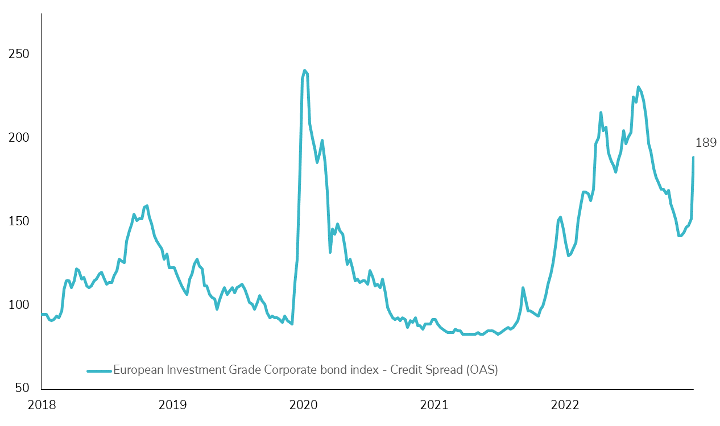What happened last week?
Central banks: The European Central Bank raised its deposit facility rates by 50 basis points (bps) despite the global turmoil in the financial system. The ECB justified this action by pointing out that its primary objective was to control inflation. And inflation remains too high in Europe not to raise interest rates. It also committed itself to maintaining a normal functioning of the financial system by leaving the doors open to intervene: "all financial facilities can be used". For the rest, the ECB did not give any indication about the future (no mention of future rate hikes) and clearly indicated that it would be "data dependent". In U.S., the Federal Reserve will release its latest rate decision on Wednesday. A 25bp hike (the latest?) is still expected by the market.
Rates: The yield on 10-year U.S. Treasuries briefly fell below 3.3%, its lowest level since September 2022. Treasury market volatility, with the MOVE index hitting 200 bps (!) last week, is at its highest level (above the Covid crisis) since 2008. Uncertainty surrounding the future path of the Fed's hiking cycle has caused the front end of the U.S. Treasury yield curve to drop from over 5% 10 days ago to 3.7% at the time of this writing. The steepening of the yield curve also shows that the end of this rate hike cycle may be near. Indeed, the difference between the 2-year and 10-year U.S. Treasury yields closed at -40 bps, 50 bps higher than a week ago (-90 bps). In Europe, the movement was similar as the German 2-year yield fell 70 bps to 2.4% over the past week, despite the ECB's 50 bps rate increase. It is worth noting that this is the first time in this rate hike cycle that the German 2-year yield is below the ECB's deposit facility rate.
Credit: US Investment Grade (IG) corporate bonds had another positive week (+0.8%), still benefiting fully from their rate components (performance of US Treasuries). But the devil is in the details, this is the second week in a row that credit spreads on US IG bonds have widened, by over 20 bps to 90 bps. In the high yield (HY) sector, bonds widened more than 50 bps for the second consecutive week. U.S. HY bonds lost 1% month-to-date, compared to a 1.75% gain for U.S. IG bonds. In Europe, the credit market was also under pressure, as evidenced by the iTraxx Xover Index, a good gauge of the European high yield market, which posted its largest weekly credit spread widening (+83 bps) since mid-September 2022. Finally, the AT1/CoCo bond market suffered the most with a loss of nearly 10% on the week, the largest weekly loss since March 2020.
Emerging market: Emerging market corporate bonds were slightly negative last week (-0.1%). Like high yield bonds, emerging market credit spreads widened significantly, by more than 40 bps, to the point where the drop of US Treasury yields was not enough to compensate. China surprisingly reduced the reserve requirement ratio for banks (for the last time this year?) by 25 basis points on Friday. The PBOC justified the reduction in order to "achieve a good mix of macroeconomic policies, improve the level of services for the real economy and maintain reasonably sufficient liquidity in the banking system." In Argentina, the central bank was forced to raise benchmark interest rates by 300 bps to 78% (!) due to the recent rise in the inflation rate.



.png)
